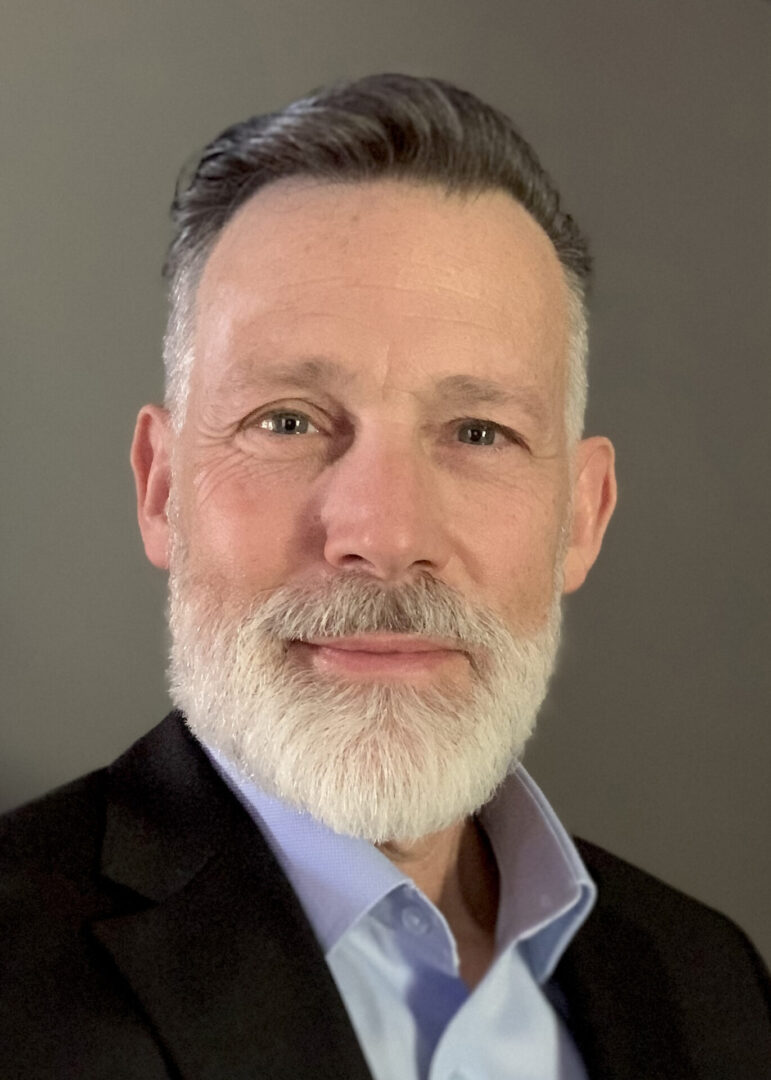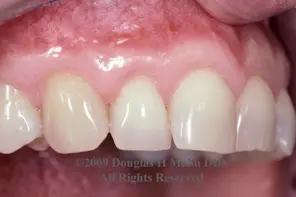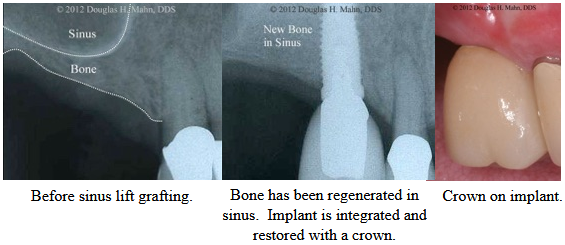GINGIVAL & BONE GRAFTING

Douglas H. Mahn, D.D.S.
Periodontics, Cosmetic Periodontal Surgery,
and Dental Implants
“Creating Beautiful and Healthy Smiles”
Call: 703-392-8844
Advanced Gingival and Bone Grafting Techniques
Your oral health is very important. Healthy teeth, gums and bone contribute to your overall health. A beautiful smile makes you more confident and attractive to other people. Your smile is one of the first things people notice about you. Failure to maintain good oral health can lead to poor overall health, sickness, difficulty eating, and an unattractive smile. You deserve the best.
Gingival (Gum) Grafting:
Great advances have occurred in the field of periodontics. This is especially true in the area of gingival (gum) grafting. In the past, this procedure was associated with questionable esthetic results, bleeding, and discomfort. This is no longer true.
Atraumatic surgical techniques, an emphasis on esthetics, and the ability to use alternative graft materials has allowed periodontists to achieve amazing results. Dr. Mahn has been in the forefront in the use and development of these techniques and materials.
Atraumatic surgical technique is one key to predictable esthetic results. “Tunnel” techniques require an advanced level of expertise. Some dentists do not perform them because they require additional time. Dr. Mahn, however, feels the time investment is well worth the highly esthetic results.
In the past, connective tissue grafting was performed using donor soft tissue taken from the patients’s palate. This donor site was often associated with bleeding and pain. Dr. Mahn, however, can perform the same procedure using processed tissue derived from an organ donor. This material, called AlloDerm, is a regenerative matrix tissue. It has been used in medicine for many years. Dr. Mahn has been using this material for approximately 25 years and has several articles published on its use. In addition to reducing patient discomfort, this material permits treatment of many teeth in a single visit. To learn more please visit the website, biohorizons.com.


Ridge Augmentation, Bone Grafting, Socket Preservation:
A tooth is held in place by the bone in a tooth socket. The bone is called the Alveolar Ridge. When a tooth is lost, the remaining bone begins to resorb away. The remaining area of bone is called the Residual Ridge. When the residual ridge resorbs, a defect develops. This defect can lead to an unnatural and unesthetic appearance. The loss of bone can also prevent dental implant placement.
Regenerating bone in an area where a tooth was lost can go by several names. These include Ridge Augmentation, Bone Grafting, and Socket Preservation. Preventing and treating residual ridge defects is an advanced form of surgery. Especially when esthetics are concerned, an experienced clinician is required. The clinician must be able to properly diagnose the problem, choose the correct treatment modality, and perform the technique with a hight degree of skill. At times a combination of techniques are required.
Often bone regenerative techniques are most beneficial when performed at the time of tooth removal. This has led to the name Socket Preservation. As well as being a predictable time to regenerate bone, it permits extremely esthetic results and reduces the number of surgical visits.

Bone Regeneration and Sinus Lift Grafting:
A major limiting factor in implant placement is the availability of bone. Adequate amounts of bone are necessary for proper implant placement with predictable results.
Major advances in bone regenerations have taken place. Bone can be regenerated when it is deficient in the vertical and horizontal directions. Bone can also be regenerated in the lower portion of the sinus cavity using a procedure the “sinus lift”. These procedures permit implant placement in places where previously it was not possible.
The before and after radiographs, show a significant amount of bone regeneration. The abundant volume of bone permitted placement of a dental implant of ideal size and in the ideal position. A crown was placed on the implant. The patient reported the implant crown felt like a natural tooth was able to chew on it normally.


Grafting Materials:
Dr. Mahn uses only the safest and most effective grafting materials available. Companies that provide graft materials all must follow strict government guidelines. In addition, Dr. Mahn prefers to work with companies that are members of the American Association of Tissue Banks (AATB.org). As members of this organization, these companies submit themselves to strict guidelines.
You should always feel comfortable asking Dr. Mahn (or any doctor) about the graft materials that may be used in your care and what options you have.
Autografts are graft tissues that come from the patient themselves. While being very effective, they usually involve a second surgical site and the availability of tissue from this site may be limited. Donor tissue sites can also be a source of post-operative problems, including discomfort and bleeding.
Allografts come from human donor sources other than the patient. These types of grafts have been available for decades. They have an excellent history of success and safety. They can eliminate the need for an additional surgical site.
Xenografts come from animal donor sources. These grafts have been available for decades and also have an excellent history of success and safety. Bovine (cow) allografts are very common. Like human allografts, they can eliminate the need for an additional surgical site.
Ask Your Doctor
It is beyond the scope of this website to go into every detail of gingival and bone grafting. You should, however, have a basic understanding of what is involved in your treatment and what you can expect will be your final results. Do not be afraid to ask your doctor questions. If necessary, get a second opinion.